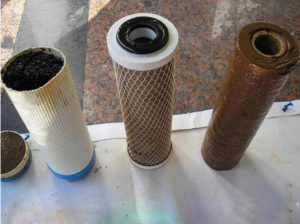Reverse osmosis is an efficient and energy-saving technology that has become the preferred water treatment technology in modern industry. So what exactly is reverse osmosis?
The concept of reverse osmosis
Reverse osmosis is a membrane separation technology developed in the 1960s, which relies on reverse osmosis membranes to separate solvents and solutes in a solution under pressure. It is to use sufficient pressure to separate the solvent (usually water) in the solution through reverse osmosis membrane (a semi permeable membrane). Contrary to the direction of osmosis, reverse osmosis method larger than osmotic pressure can be used to separate, purify and concentrate the solution.The main separation object of reverse osmosis membranes is the ion range in the solution.
The principle of reverse osmosis
Permeation is a physical phenomenon in which a semi permeable membrane is placed between two types of saline water with different concentrations to separate them. The water on the lower concentration side will penetrate through the membrane and penetrate into the water with higher concentration, while the salt content will not penetrate until the salt concentration on both sides is equal. If a pressure is applied on the water side with high salt content, the result can also stop the above seepage, and the pressure at this time is called osmotic pressure.
If the applied pressure is further increased, it can cause water to permeate from the side with high salt content to the side with low salt content, and the salt is intercepted, forming reverse osmosis.
In general, the principle of reverse osmosis is to apply a greater pressure than the natural osmotic pressure in the water containing salt to make the osmosis go in the opposite direction, and press the water molecules in the raw water to the other side of the membrane to obtain pure water that removes salt, microorganisms, organics and other substances. Due to the pore size of the reverse osmosis membrane being only 0.0001 microns, a bacterium needs to be reduced by 4000 times, and a filterable virus needs to be reduced by more than 200 times to pass through, resulting in an effective removal rate of over 96%.
Advantages of reverse osmosis separation
No heating required, no phase change;
Low energy consumption;
The equipment is small in size, easy to operate, and has strong adaptability;
No pollution to the environment.
The Use of Reverse Osmosis Technology
Remove organic matter, bacteria, colloids, and other impurities dissolved in water;
Wastewater treatment and reuse;
As a concentration method, it can recover valuable components dissolved in solution.
Industry suitable for application of reverse osmosis technology
Electric power industry: boiler make-up water;
Electronic industry: ultra pure water for semiconductor industry, integrated circuit cleaning water;
Food industry: formula water, production water;
Beverage industry: formula water, production water, washing water;
Pharmaceutical industry: process water, formulation water, washing water, injection water, drug concentration and separation;
Chemical industry: production water, wastewater treatment, concentration and separation of valuable substances;
Drinking water engineering: pure water preparation, drinking water purification;
Petrochemical industry: advanced treatment of oilfield injection water and petrochemical wastewater;
Seawater desalination: Production and domestic water for island areas, coastal water scarce areas, ships, seawater oil fields, etc.

Due to the efficient and energy-saving advantages of reverse osmosis technology, it has attracted much attention in the water treatment industry. Multiple countries are currently researching and developing reverse osmosis water purification, including many household water users, who are gradually using reverse osmosis water purification to improve their quality of life.


